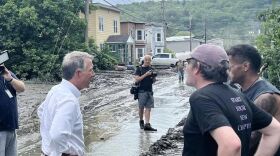Key topics covered during Vermont Governor Phil Scott’s latest briefing on flood recovery today included aid for mobile home owners displaced by flooding and how to deal with mounds of debris from flood cleanup.
Governor Scott began his briefing noting that guidance for a $20 million state grant program to help flood damaged businesses is now available from the Agency of Commerce and Community Development. He also displayed two new versions of the Vermont Strong license plate, first issued after Tropical Storm Irene in 2011, to raise money for flood recovery.
“Anything raised will support those impacted by flooding. Now we decided to keep the design similar to the one used after Irene with a few minor tweaks. Time and time again Vermonters have shown their willingness to step up to help their neighbors. That’s why I thought it was important to change ‘I am Vermont Strong’ to ‘We are Vermont Strong’. And through the resilience so many have shown from Irene to the pandemic to this year’s never-ending rain storms it’s clear we’re more than just Vermont Strong. We’re tough too. So we have a second option.”
Department of Public Safety Commissioner Jennifer Morrison confirmed reports that there was a second flood-related death.
“67-year-old Robert Kerker of New York state drowned in the swollen waters of Stony Brook near Stockbridge while hiking the Appalachian Trail. Our condolences go out to all of Mr. Kerker’s family and friends.”
According to the Vermont State Police report, Kerker was from Rhinebeck, New York.
So far 61 mobile homes have been deemed uninhabitable. Four mobile home parks — in Ludlow, Johnson and two in Berlin — experienced the most significant damage during flooding. Governor Scott said that is provoking discussion on where to best place those neighborhoods.
“To add to the challenge that we have in that situation, FEMA does have a program where they have units that are available that we could lease in the interim because we may not be able to find replacement homes for many. But FEMA won’t allow those to go back into a floodway. So some of the parks that are available that might have lots available because all the homes were destroyed would not be viable for this option. No decisions have been made but I think in the future we’re going to have to really think about where these manufactured home lots are located.”
Another problem state officials are addressing is piles of debris – both from people cleaning up and natural residue left on land and in waterways. Agency of Natural Resources Secretary Julie Moore provided advice and resources for debris management.
“Any human made debris is rightly considered solid waste and there are no restrictions for manually removing these materials from rivers and streams and riparian areas as part of flood cleanup. If the conditions caused by natural debris are creating an immediate risk, emergency work to remove the material can proceed under town authority so long as the Agency of Natural Resources is notified of the work within 72 hours. To the extent flood deposited natural debris is not creating a specific hazard it’s really best to leave it where the river dropped it off.”

















